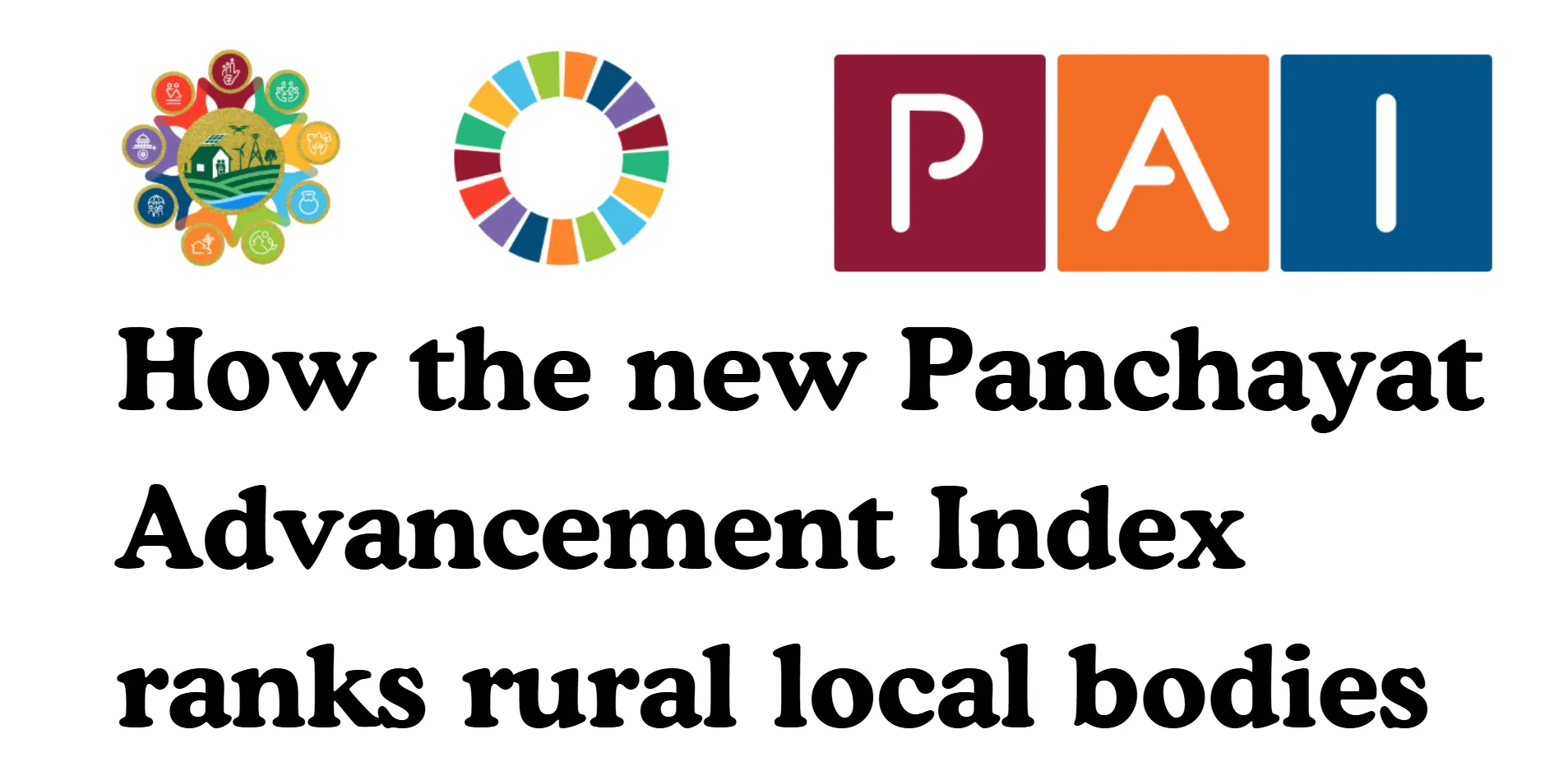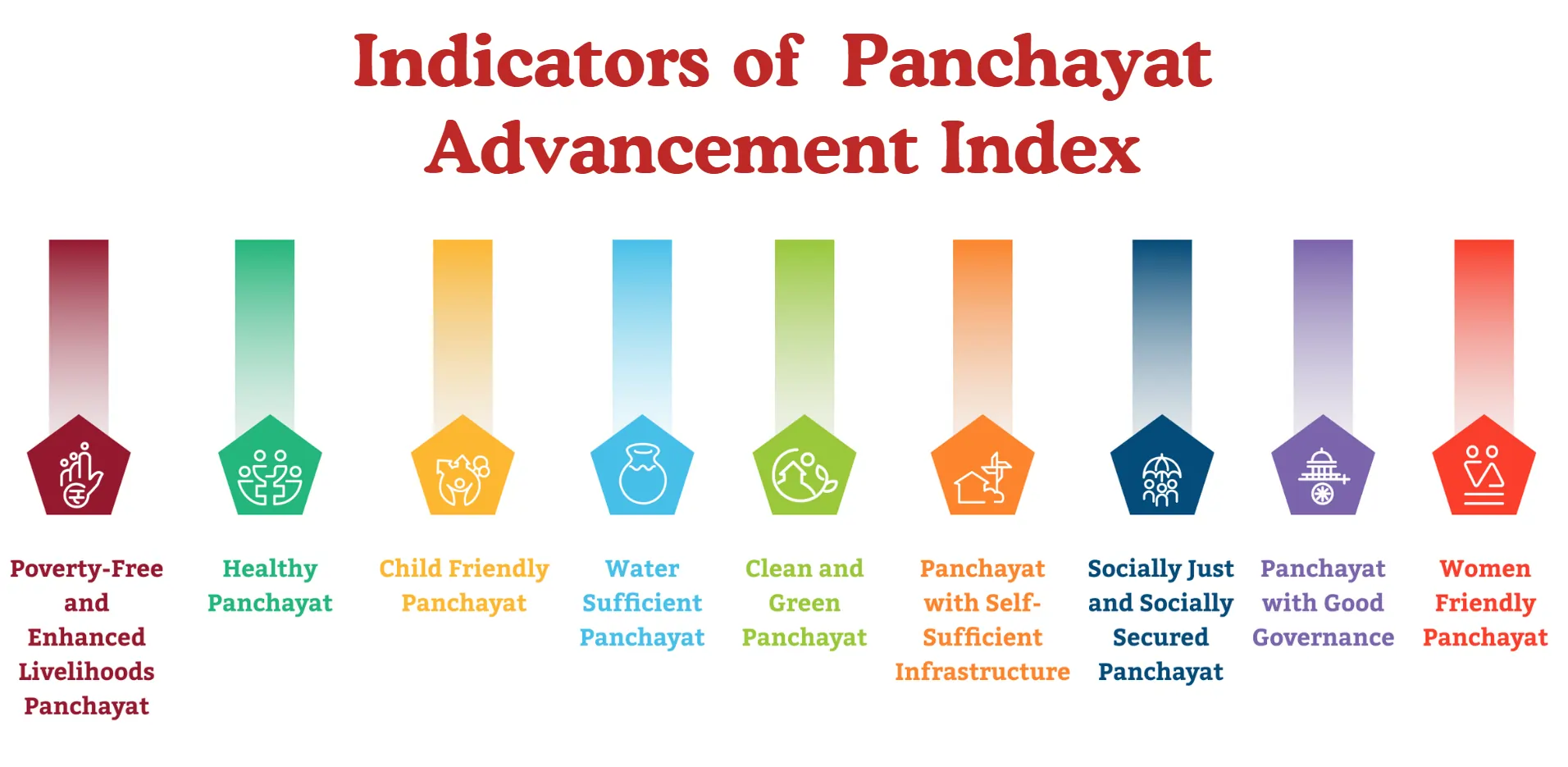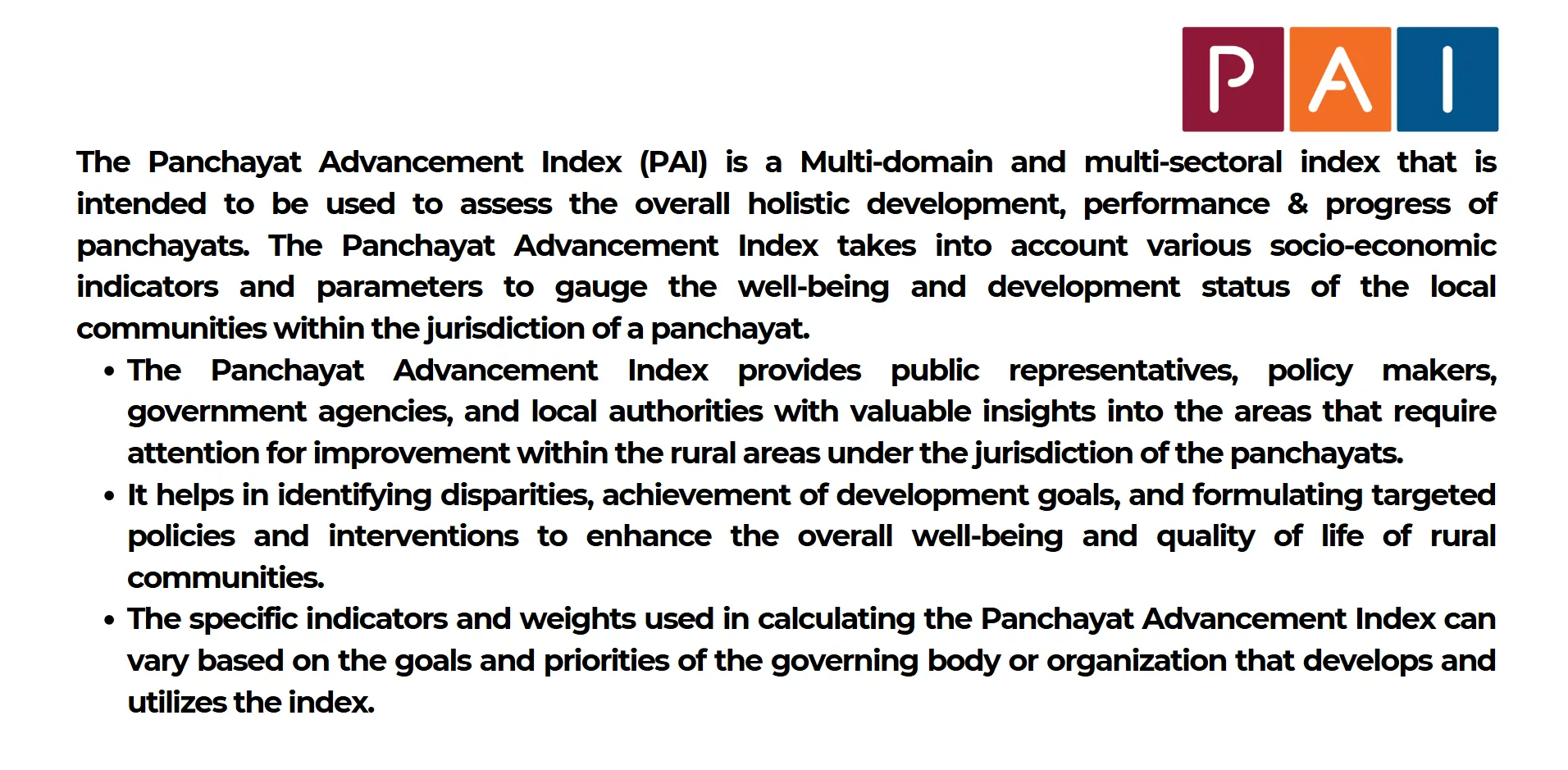Through its Panchayat Advancement Index (PAI) the Indian government establishes a ranking system to rate local bodies regarding their operational performance which enables them to track deficiencies for stronger accountability levels in policymaking throughout rural areas for sustainable development.

The Panchayat structure functions as the primary governance method in India's rural areas which promotes resident participation through decentralized administration. The Panchayat Advancement Index (PAI) became operational through a government initiative to reinforce the vital structure while matching its objectives with the Sustainable Development Goals (SDGs). The new ranking instrument offers evaluation of rural local bodies by assessing their performance in essential development areas using data analytics to provide performance insights. The PAI reveals both successful outcomes alongside essential deficiency spots which drive accountable policy decisions based on accurate information. This scoring system together with a strong indicator framework creates a platform for Panchayats to compete in a healthy manner to target excellence. Through its process of identifying top-performing Panchayats and helping underperforming ones enhance their efforts the PAI functions as an attractor of sustainable development along with inclusiveness in rural India. This research investigates the Panchayat Advancement Index through evaluation of its methodology compared to its effects, hurdles and forthcoming directions in rural governance improvement.
The Panchayat Advancement Index (PAI) represents what?
The Panchayat Advancement Index serves as a complete measurement tool which evaluates rural local body performance through its standardized framework. The framework exists to strengthen governance.
Purpose and Objectives of the PAI
PAI was created to help Panchayats meet higher standards by using a single approach to evaluate their overall performance in a variety of areas. The index forms an accurate correspondence between its measurements and the United Nations Sustainable Development Goals to drive specific efforts toward poverty reduction along with health outcomes, education and environmental sustainability along with other related SDG priorities. The system of ranking Panchayats leads the agencies to use best practices while developing their governance abilities.
Key Themes of the Index
Rural development relies on below essential themes as the foundation of the PAI. These themes include:

Each theme contains multiple indicators to measure the specific rural obstacles and possibilities within a particular area.
Scoring and Ranking System
Through the PAI scoring system Panchayats receive precise information about their progress in development. The Panchayats assign points on a range between 0 and 100 which divides into five stages: Beginner (below 40), Aspirant (40-60), Performer (60-75), Front Runner (75-90), Achiever (90-100). This classification simultaneously functions as an inspirational tool alongside providing performance benchmarks.
Data Collection and Assessment
The assessment of PAI depends on 435 selected indicators that guide their data-driven method. The information gathered through multiple sources maintains both high accuracy and reliability levels. Governance transparency seeks periodic assessments to let stakeholders track and validate the direct effects of their policies and strategies.
Role in Rural Development
The index promotes constructive competition between Panchayats through innovative partnership development. Through this tool communities acquire the power to solve their specific problems by implementing data-driven solutions. The identification of strong and weak performers through the PAI implements an explicit strategic guide for developing balanced and inclusive growth.
The Panchayat Advancement Index represents a key instrument which transforms rural governance through its establishment of a lasting approach to development that promotes equality and accountability. The tool creates possibilities to acquire meaningful outcomes in rural India.
Why Was the PAI Introduced?
The Indian rural local bodies implemented the Panchayat Advancement Index (PAI) as an accountability and evidence-based governance instrument for sustainable development.

1. Bridging the Development Gap: Development challenges in rural parts of India consist of poverty together with insufficient infrastructure and uneven distribution of resources among its communities. Authorities created the PAI as an assessment instrument to link various developmental goals. Through key performance tracking in health, livelihoods and sanitation the Panchayats gain the power to handle specific local needs more effectively.
2. Driving Evidence-Based Governance: The PAI requires Panchayats to measure their performance through accurate data collection and performance indicators. The strategy enables better decision-making processes which also lead to improved policy development. The well-established measurement system enables developers to base their rural strategies on concrete prove instead of using unreliably interpreted and personally evaluated data.
3. Aligning Rural Governance with SDGs: The PAI emerged as an innovative monitoring tool to help India reach its Sustainable Development Goals by the year 2030. Through the index SDGs include gender equality together with environmental sustainability and poverty eradication form part of rural governance framework. The national and global development agendas benefit from local actions that become properly aligned through this approach.
4. Fostering Healthy Competition: The PAI implements ranking criteria which enables rural organizations to innovate together. The performance models created through high-ranking Panchayats act as examples while lower-performing Panchayats gain motivation to enhance their activities. The rating system boosts competition between Panchayats which leads to shared growth achievements.
How Does the PAI Work?
Through its data-based Panchayat Advancement Index (PAI) system rural local bodies obtain performance assessments to improve governance methods while implementing sustainable development projects.
Framework and Methodology
The PAI system uses nine critical themes to rate Panchayats for their performance of poverty reduction and health services together with infrastructure creation and environmental sustainability practices and governance implementations. The 435 localized indicators divide these nine development themes to form a complete analysis system of rural development. Using both quantitative and qualitative data assessment helps the methodology reveal the detailed grassroots realities and achievements.
Data Collection Process
The PAI method uses surveys together with administrative records and community-based input to build accurate and inclusive data collection. The system implements verification checks to verify the reliability of all data sources. The process serves to enhance Panchayats' capability by letting them set vision-based goals using measurable performance indicators for successful outcomes.
Scoring and Ranking
All indicators have a scoring system that ranges from zero to one hundred allowing for clear assessment comparisons between Panchayats. It enables Panchayats to align their performance with five achievement categories known as Beginner, Aspirant, Performer, Front Runner and Achiever. Through its traditional ranking methodology Panchayats can identify their strong points in addition to locating development challenges where actionable planning can become possible.
Feedback and Improvement
Through periodic assessments Panchayats maintain a clear view of their progress development throughout time. Using feedback processes makes it possible for local bodies to detect operational problems while implementing strategic changes. Panchayats at higher ranks function as educational examples which promote reciprocal improvement between communities throughout the regions.
Impact of the PAI
Through its implementation the Panchayat Advancement Index (PAI) delivers significant changes to rural governance assessment while fostering better accountability and sustainable national development.
- Highlighting Developmental Gaps: The PAI successfully discovers existing problems in rural development needing improvement. The evaluation process across different indicators demonstrates that Panchayats face problems in healthcare, education, sanitation and livelihood sectors. The evaluation system allows authorities to create focused solutions which solve identified developmental gaps
- Encouraging Healthy Competition: The ranking system fosters a sense of healthy competition among Panchayats. The performance assessment system establishes different categories for local bodies which leads lower-ranking groups to work on enhancement and score improvement. Panchayats with superior performance become inspirational examples which drive their peers into learning and teaming up with each other.
- Empowering Evidence-Based Decision-Making: Through its data-driven method the PAI allows Panchayat leaders and policymakers to make decisions based on solid evidence. The usage of concrete performance analytics helps organizations redirect resources for better achievement of defined outcomes.
Through its Panchayat Advancement Index the rural governance system now achieves development goals while creating expanded opportunities for everyone to succeed. Through its on-going influence it directs the rural development of India.
Challenges and Limitations
It requires strategic solutions to handle its barriers and implementation difficulties for effective rural development in India.
Data Collection Challenges
Information gathering, accuracy and consistency create a substantial challenge for the successful implementation of the program. The reporting methods used across local zones create unreliable data because the PAI depends mainly on local indicators. The limited presence of technical infrastructure together with the lack of necessary expertise in some areas results in ineffective data collection and validation processes.
Exclusion of Panchayats
Some Panchayats fail to participate in the rankings because they have submitted incorrect or unusable data. Due to this exclusion condition there are developing distribution problems in addition to reduced index understanding capabilities. Small or less funded Panchayats suffer disadvantage through the ranking process thus contradicting the inclusive spirit of the index.
Capacity and Resource Constraints
Most Panchayats cannot carry out proposed changes recommended by the PAI because they operate without necessary resources and technical abilities. The index findings become challenging for Panchayats to execute because they face funding limitations and receive insufficient training as well as lack of access to modern technologies.
Regional Disparities
The PAI demonstrates important performance gaps between states and regional areas that showcase established social inequalities. Nationwide development needs balanced resource distribution because high-performing states dominate other states with lower performances.
Sustainability of the Framework
Another limitation arises from the need to guarantee the continuous sustainability of the Panchayat Advancement Index. The index becomes ineffective when not updated because it fails to address developing rural situations and priorities appropriately.
To achieve the index's maximum potential for transformative rural governance nationally it becomes essential to resolve existing implementation barriers of the Panchayat Advancement Index.
Future Prospects of the Panchayat Advancement Index
The Panchayat Advancement Index (PAI) creates new opportunities for rural governance through its sustainable growth framework while promoting inclusive practices as well as evidence-based decisions at grassroots administration level throughout India.
Scaling the Framework Nationwide
To keep Check on all 2.5 lakh Gram Panchayats this frame work is created. The comprehensive rural progress view emerges when Panchayats that have been excluded participate in data validation activities to solve existing challenges. Universal expansion at the national level would foster balanced access and create additional thorough understanding.
Integration with Other Initiatives
The PAI operates as a method which can connect to other rural development initiatives including Mahatma Gandhi National Rural Employment Guarantee Scheme (MGNREGS) and Swachh Bharat Abhiyan. Multiple partnerships between governance approaches would increase their combined effect on efficient resource distribution throughout projects.
Technological Advancements
The PAI can use artificial intelligence and machine learning technology to enhance its methodology and enhance accuracy. The use of digital platforms will optimize data collection, analysis and distribution methods to deliver more rapid assessments and better referring materials to stakeholders.
Policy Shaping and Capacity Building
The continuous evolution of the index will establish an essential role in developing national and regional policies. The PAI generates information that leads governments to focus investments and reform execution for important rural development problems. The implementation of grassroots capacity-building programs will enable Panchayats to use PAI data results for their benefit.
Driving Global Recognition
Through its conceptual design the PAI can inspire worldwide emulation of localized SDG implementation frameworks thus establishing India as a leading authority in such SDG frameworks. India should participate in worldwide rural development plans through its share of best practices and innovations.
Conclusion
With its evidence-based rankings to improve rural governance and quantifiable progress measurement systems, the Index functions as a ground-breaking framework. SDGs achievement and sustainable growth progress depend on PAI's capability to show development deficiencies while stimulating competition between local organizations and ensuring Panchayat commitments with global development targets. Future development of India’s rural areas will be enhanced through PAI potential growth, integration capacity and innovative capabilities to produce substantial grassroots-level effects. Transformative rural development finds its path through the application of the PAI.